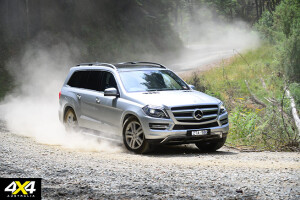Latest Review

4X4 Of The Year 2012
Our five short-listed vehicles for 4X4 of the Year couldn’t be more diverse but they are all chasing the same prize and only one will win…
It’s been a big year for new 4X4s and we have gathered the pick of them to battle it out to decide just what will be the 4X4 of the Year.
The short-listed vehicles include the reigning 4X4 of the Year champion, the Jeep Grand Cherokee, back in with another shot at the title thanks to a new diesel engine option. It’s a similar story for the Range Rover Vogue with its new 4.4-litre TDV8 while Mercedes-Benz has re-introduced its venerable G-Wagen to the Australian market after a quarter of a century absence.
Here we have the diesel version, the G 350 Blue TEC. Meanwhile, the Toyota LandCruiser 200 gets another shot at glory via a new base-spec GX variant while the only all-new vehicle in the group, and the only one with petrol power, is the Toyota FJ Cruiser.
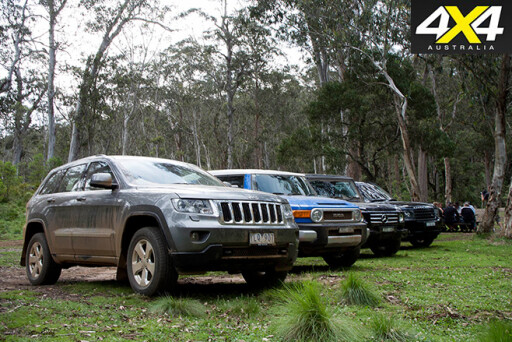 Jeep’s WK Grand Cherokee petrol V6 won 4X4 Australia’s top gong last year thanks to its excellent value package, impressive on-road performance and decent off-road ability.
Jeep’s WK Grand Cherokee petrol V6 won 4X4 Australia’s top gong last year thanks to its excellent value package, impressive on-road performance and decent off-road ability.
It’s back this time with the much-anticipated 3.0-litre V6 turbo-diesel engine and once again we have the Laredo specification equipped with Selec-Terrain and height adjustable air suspension. At $54,450 as tested it’s an early favourite to take back-to-back titles.
The Range Rover Vogue is nearing the end of this third generation model’s life, but its last hurrah is a sublime 4.4-litre TDV8 engine mated to a silky smooth eight-speed automatic transmission. Unlike the previous 3.6-litre TDV8, this new 4.4-litre engine has a sequential bi-turbo system rather than parallel twin turbos, while the eight-speed auto is exclusive to this engine in the Rangie line up. The Vogue’s new driveline is accompanied by a number of interior and specification upgrades and, as tested, will set you back $196,690.
 The Mercedes-Benz G 350 BlueTEC is also at the upper end of the price range at $169,480 (as tested), but its 30-plus years of incremental development, not to mention its triple differential locks makes it a well proven off-roader.
The Mercedes-Benz G 350 BlueTEC is also at the upper end of the price range at $169,480 (as tested), but its 30-plus years of incremental development, not to mention its triple differential locks makes it a well proven off-roader.
The LandCruiser 200 Series GX model is the Cruiser that farmers, miners and other sectors of industry have been asking for since the 200 landed in 2007. Stripped of many features including carpets and third-row seat, the GX Cruiser retains its twin-turbo 4.5-litre V8 diesel engine, six-speed auto and 3500kg towing capacity, but at $77,990 it’s still not cheap. With less weight on board the payload is up to 710kg and dual fuel tanks are standard.
The polarising retro-inspired style of the FJ Cruiser hides mid-wheelbase Prado underpinnings so we expect a great ride and strong off-road performance for the funky FJ. But how functional would the suicide-style rear doors and thick side pillars be in the real world? And can a petrol V6 engine compete with the efficient turbo-diesels? Is the part-time four-wheel drive system of any real benefit, or is it just keeping the FJ’s price point low at $44,990?

TEST ROUTE
Contrary to what many people may think, a week of testing the 4X4OTY vehicles isn't just a swan around to the judges’ favourite or pretty locations to indulge one's ego. No, there's purpose and design in our wanderings.
This year, with our judges ensconced in their charges, we headed north out of Sydney cruising the freeway until we peeled off the dual lanes onto a lesser road in search of an old quarry near Freeman’s Waterhole where you can pick one of a half dozen rocky, eroded tracks and test out your skills and/or the capability of your 4X4.
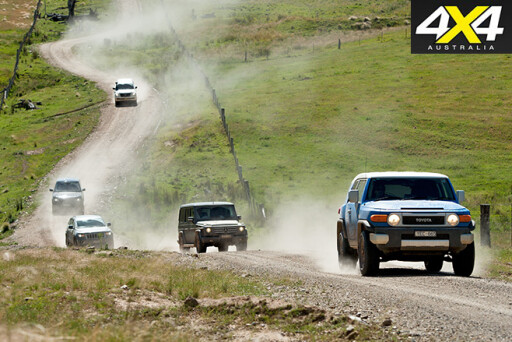 In such places it’s easy to bend or break a vehicle (something we don't set out to do as it proves nothing), but here we get a good idea of suspension travel, wheel articulation, the capability of traction control (every modern vehicle seems to have it these days), diff locks and more.
In such places it’s easy to bend or break a vehicle (something we don't set out to do as it proves nothing), but here we get a good idea of suspension travel, wheel articulation, the capability of traction control (every modern vehicle seems to have it these days), diff locks and more.
Leaving there relatively unscathed we headed to the sand mecca of Stockton Beach. For many four-wheelers this is their favourite playground close to the 'burbs of Sydney and Newcastle and once you cruise the beach and wind through an untracked patch of dunes you can easily understand why. Getting bogged here is part and parcel of the experience, but it proves how good some of the traction control systems work in this soft shifting environment and how engine and gearbox management systems mate together.
Next day saw us threading through the hills and across second- and third-class bitumen roads as we headed to Gloucester and then higher into the mountains around Barrington Tops. Nature played us a bonus with heavy rain as we headed along ever more slippery tracks to our camp for the night at the Manning River campsite.
 Rutted tracks had turned to mud-filled, slippery trenches as we headed off next morning winding along forest trails, all of us wishing we had better (read: more aggressive) tyres than the factory fitment.
Rutted tracks had turned to mud-filled, slippery trenches as we headed off next morning winding along forest trails, all of us wishing we had better (read: more aggressive) tyres than the factory fitment.
Slippery tracks gave way to second-class dirt roads, then narrow bitumen country roads as we headed south, looking for a tyre repair place for a couple of slow leaks.
More of the same was on the agenda the next day as we headed through rich farming country and on to Abercrombie River National Park where we found a few fast forest trails that spanned some open, ridge-top country. Entering the park we headed along the Abercrombie Fire Trail to The Beach camping area, the track being typical of the Great Divide; steep and winding; up hill and down dale.
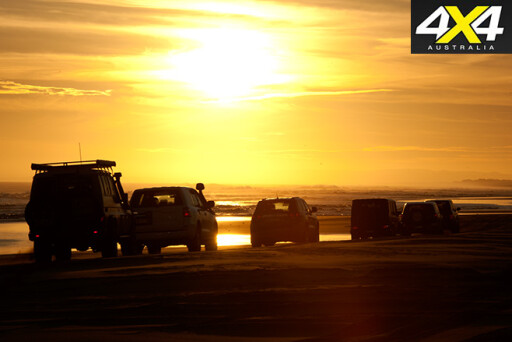 Our last day found us headed along the Silent Creek and Brass Walls fire trails that not only tested traction control, gearing, engine flexibility and performance, but also ride comfort and vehicle dexterity.
Our last day found us headed along the Silent Creek and Brass Walls fire trails that not only tested traction control, gearing, engine flexibility and performance, but also ride comfort and vehicle dexterity.
Two hours later we were in Goulburn and then cruising north towards Sydney. The list of damage was minor; a few repaired tyres, some plastic underbody protection ripped off, and the odd scratch or three.
Our job was done – or nearly so. Words had to be written and points pondered over to find a winner for this year's 4X4OTY. Honestly, it’s a lot harder than it looks.
JUDGING CRITERIA
 VALUE FOR MONEY
VALUE FOR MONEY
This is judged according to a vehicle’s equipment level, safety features and price relative to its direct competitors.
DOING THE JOB
This is judged according to a vehicle’s design brief. In the case of a 4X4 wagon, we look at how well it performs on- and off-road, and its interior accommodation for passengers and cargo.
BUSHABILITY
This is how well a vehicle is equipped for Aussie off-road and outback travel. Suitability of the wheel and tyre specification, touring range, available accessories and underbody protection are some of the factors considered here.
BREAKING NEW GROUND
This refers to advancements in technology and design. If a vehicle has the latest safety features, worthy engine technology or an advanced driveline, it will score
well here.
BUILT TOUGH
This is the obvious one. It refers to how strong a vehicle is, and how well it will cope with the rigours of tough off-road and outback driving environments.
JUDGING PANEL
It's not every day you get six people together in the one place for the one event whose combined 4X4 experience totals 209 years. We did... and it was for this year's 4X4OTY.
Our judges have driven everything from Series I Land Rovers and World War II Jeeps to the fastest 4X4s on the planet… real experts in every facet of four-wheel driving… who can cut through the PR hype, the engineering jargon and the plain old bulldust to get to the very heart of the matter.
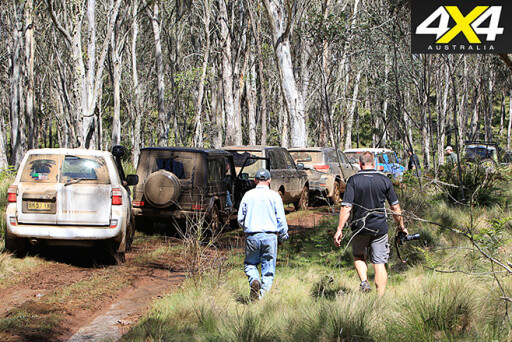 Fronting our role call of the best in the business is the 'young un' of the group, Glenn 'GT Camper' Torrens. A motoring journo for 20 years, for the last 10 years he's been involved with testing 4X4s, drives a HiLux as his daily set of wheels and reckons the worst 4X4 he has ever tested was a Tata ute .
Fronting our role call of the best in the business is the 'young un' of the group, Glenn 'GT Camper' Torrens. A motoring journo for 20 years, for the last 10 years he's been involved with testing 4X4s, drives a HiLux as his daily set of wheels and reckons the worst 4X4 he has ever tested was a Tata ute .
Next in our judging group is Don 'Been bogged everywhere' Shewring, our guest judge from TJM HQ in Brisbane. Now Don may have only been in the 4X4 recreational field for five years or so, but before that he punted around the bush and the outback in a series of 4X4 utes selling heavy plant equipment to mining companies. He currently drives a well set up (as you'd expect for the Distribution and Development Manager from TJM) V8 Toyota Troopie.
Matt 'Got Wheels, Driven it' Raudonikis cut his teeth in an FJ45 Cruiser on Rainbow Beach back in the early 1980s and he has been testing cars and 4X4s since the 1990s, as well as being editor of a national 4X4 magazine between 2000 and 2007.
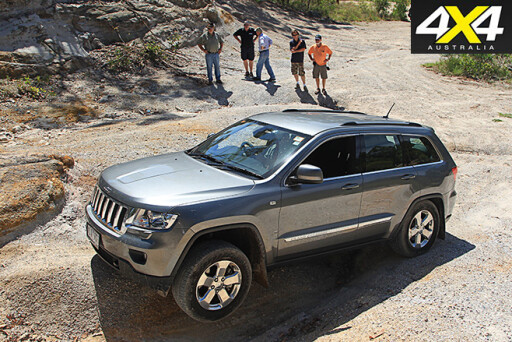 As the current editor of 4X4 Australia, Fraser 'Field Marshal' Stronach got into four-wheel driving from his job as a geologist field assistant back in 1970 when he bounced his way along tracks in the backblocks of NSW in a Datsun (read Nissan) G60.
As the current editor of 4X4 Australia, Fraser 'Field Marshal' Stronach got into four-wheel driving from his job as a geologist field assistant back in 1970 when he bounced his way along tracks in the backblocks of NSW in a Datsun (read Nissan) G60.
Road-testing bikes from 1979, by 1987 he was involved with a national 4X4 magazine and two years later became its editor, a job he held until 2000. Since then as a freelance writer and road tester he has driven just about every new 4X4 on the planet.
It was way back in 1965, when Ron 'Lose a Wheel or Two' Moon drove his first 4X4, a Series II Land Rover when he joined the Army as an auto elec apprentice. Taking over 4X4 Australia magazine in 1988 he remained editor for nearly 15 years. Now, as editor-at-large, he drives only 'real' 4X4s (mainly his Nissan Patrol) in some of the world's greatest places, and his most embarrassing moment was when he lost two wheels off his camper trailer and Patrol respectively in the course of just three months!
 Few people in Australia can match Norm 'The Legend' Needham when it comes to 4X4 experience. He drove a Series I Land Rover as early as 1960 while his first 4X4 was an FJ40. In 1975 he took that to Cape York and wrote about it in a national 4X4 magazine.
Few people in Australia can match Norm 'The Legend' Needham when it comes to 4X4 experience. He drove a Series I Land Rover as early as 1960 while his first 4X4 was an FJ40. In 1975 he took that to Cape York and wrote about it in a national 4X4 magazine.
One of the early members of the Toyota LandCruiser Club in NSW, in 1985 he established Traction 4, the specialist 4X4 repair centre later known as ARB Artarmon. He currently owns a V8 petrol 100 Series Cruiser converted into a ute.
THE CONTENDERS
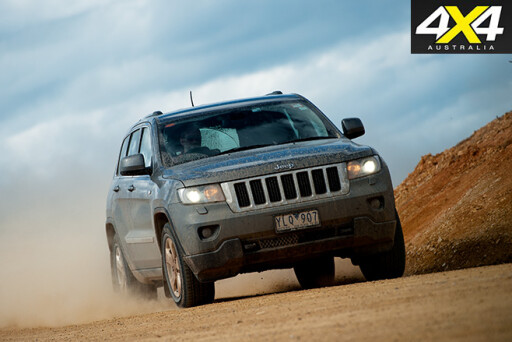 JEEP GRAND CHEROKEE LAREDO CRD
JEEP GRAND CHEROKEE LAREDO CRD
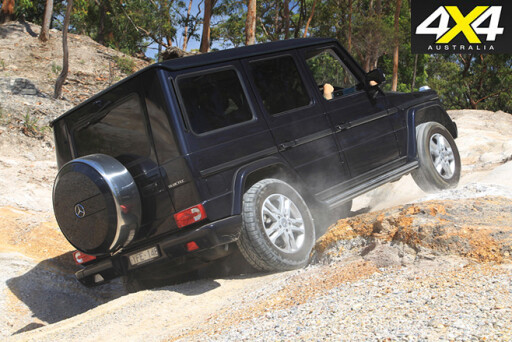 MERCEDES-BENZ G 350 BLUETEC
MERCEDES-BENZ G 350 BLUETEC
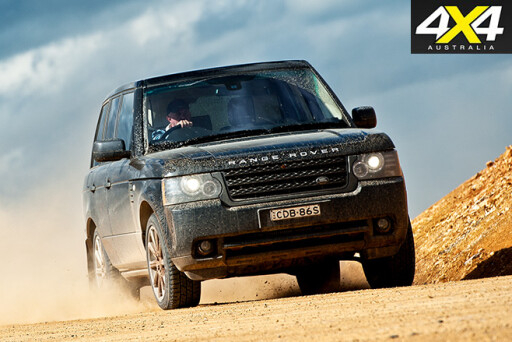 RANGE ROVER VOGUE TDV8
RANGE ROVER VOGUE TDV8
 TOYOTA FJ CRUISER
TOYOTA FJ CRUISER
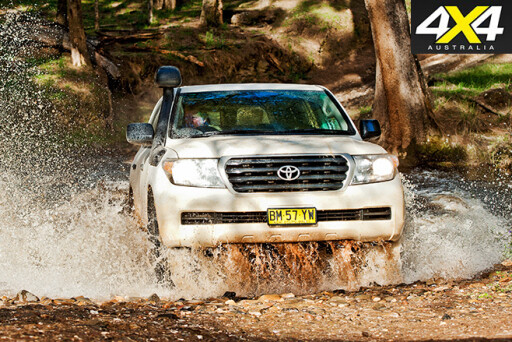 TOYOTA LANDCRUISER 200 SERIES GX
TOYOTA LANDCRUISER 200 SERIES GX
THE WINNER IS... TOYOTA FJ CRUISER
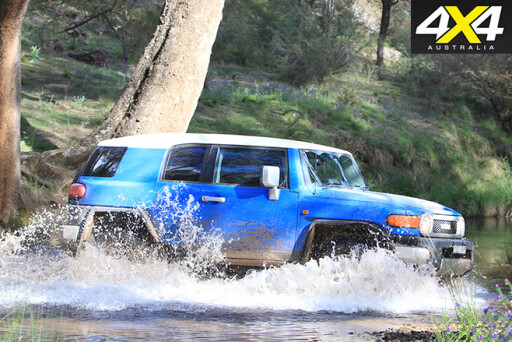 SET-PIECE 4X4
SET-PIECE 4X4
Good ground clearance, short overhangs, a relatively short wheelbase, plenty of rear axle articulation and the standard inclusion of a rear diff lock meant the FJ crawled up our rocky climb with relative ease. Vision over the big dashboard and short bonnet is okay, but not great, while the large exterior mirrors help with rearward visibility where the large pillars hinder lines of sight. The A-Trac (Active Traction Control) button gives the driver electronic traction control when in low-range but the diff lock gets it over just about anything.
TRAIL
The FJ’s almost compact proportions make it nimble and easy to punt along bush tracks. Again, visibility is just adequate but you always know where it is on the track. The low-range gearing is deep enough to control steep descents without resorting to electronic control and the V6 engine has enough grunt to get you up the hills. The ratios in the five-speed auto are well matched to varying terrain but the dogleg shifter can be awkward at times.
 SAND
SAND
The FJ’s relatively light 2000kg weight and revvy 200kW petrol engine make it a stand-out performer on the beach and dunes at Stockton. The great ramp-over angle gets it over sharp lips at the crest of dunes and the A-Trac works well to keep the little wagon punting over the soft stuff.
TOURING
Full-time 4X4 would be nice for when the road surface varies from sealed to unsealed or icy surfaces, but the safety net of electronic stability control makes up for the limitation of 2WD. The FJ’s suspension offers a nice balance of comfort and handling although the live rear axle can be upset on corrugated corners. The petrol V6 with five-speed auto is the only powertrain offering and does a commendable job in all conditions. Fuel figures of 15.4L/100km on test surprised us as it matched some of the big diesel wagons, but the FJ’s touring range is compromised by its small 72-litre fuel tank. However, there’s an acre of space under the back for an extra tank if desired.
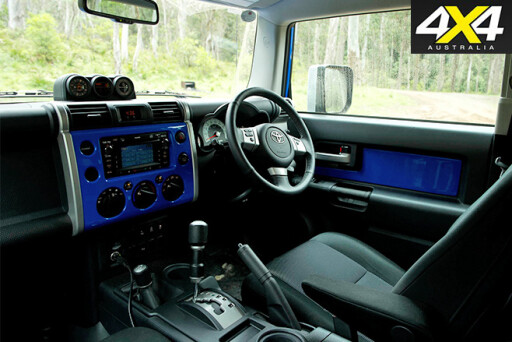 CABIN / ACCOMMODATION / EQUIPMENT
CABIN / ACCOMMODATION / EQUIPMENT
The big dashboard, flat windscreen and body-coloured interior panels take a bit of getting used to, but once you get comfortable in the FJ it’s a great place to be. It’s not a big wagon so space is at a premium and the rear seat can be a bit awkward to access through the rear-hinged doors. The rear passengers also have small windows that don’t open so their view is restricted. Vinyl/rubber floor coverings and water/stain resistant seat fabrics are practical but a few more 12-volt power outlets including one in the cargo area would be appreciated.
PRACTICALITIES / INCIDENTALS
The FJ Cruiser is a small wagon so is really only practical as a two person tourer on anything longer than weekend trips. There are plenty of accessories available for it, while the 17-inch wheels offer heaps of tyre options. Safety hasn’t been compromised by the affordable price tag with traction and stability control, ABS brakes, and six airbags as standard. Rear parking sensors and a camera are also factory fit. Payload is a moderate 510kg while towing capacity is an equally average 2250kg.
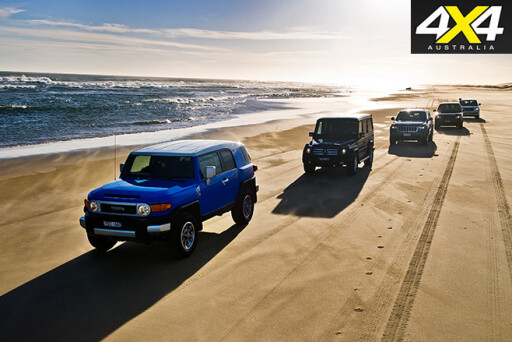 SUM-UP
SUM-UP
At the start of the week, most of the judges didn’t give the FJ much hope of winning 4X4OTY. But as the days progressed, the FJ’s fun factor, the simplicity of design, and the way it works so well came to the fore. Three judges scored it first, two scored it second and another third against tough competition. The FJ Cruiser puts enjoyment into driving on- and off-road thanks to its individual styling, ease of use, affordability and no-fuss ability. Whichever way you look at it, the FJ Cruiser is a great 4X4 and a worthy 4X4 of the Year winner.
SPECS
Engine: V6 petrol
Capacity: 3956cc
Power: 200kW@5600rpm
Torque: 380Nm@4400rpm
Transmission: Five-speed auto /part-time 4X4
Weight: 2000kg
GVM: 2510kg
Payload: 510kg
Towing capacity: 2250kg
Wheels/Tyres: 17-inch 265/70
Fuel tank capacity: 72L
ADR combined fuel consumption: 11.4L/100km
Fuel use on test: 15.4L/100km
Base Price: $44,990
Price as tested: $44,990


